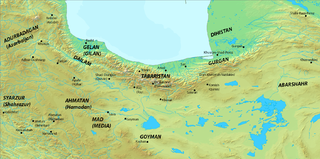Related Research Articles

Khosrow I, traditionally known by his epithet of Anushirvan, was the Sasanian King of Kings of Iran from 531 to 579. He was the son and successor of Kavad I.

Kavad I was the Sasanian King of Kings of Iran from 488 to 531, with a two or three-year interruption. A son of Peroz I, he was crowned by the nobles to replace his deposed and unpopular uncle Balash.

Hormizd III, was the seventeenth king (shah) of the Sasanian Empire, ruling briefly from 457 to 459. He was the son and successor of Yazdegerd II. His reign was marked by the rebellion of his younger brother Peroz I, who with the aid of one of the Seven Great Houses of Iran, the House of Mihran, and the eastern neighbours of the Sasanians, the Hephthalites, had him captured and executed.

Yazdegerd III was the last Sasanian King of Kings of Iran from 632 to 651. His father was Shahriyar and his grandfather was Khosrow II.

Ardashir III was the Sasanian King of Kings of Iran from 6 September 628 to 27 April 630.
Sunpadh was an Iranian nobleman from the House of Karen, who incited an uprising against the Abbasid Caliphate in the 8th century.

Jamasp was Sasanian King of Kings of Iran from 496 to 498/9. He was a son of Peroz I and younger brother of Kavad I. Jamasp was installed on the Sasanian throne upon the deposition of the latter by the nobility and clergy.

Bahrām Chōbīn or Wahrām Chōbēn, also known by his epithet Mehrbandak, was a nobleman, general, and political leader of the late Sasanian Empire and briefly its ruler as Bahram VI.

The First Perso-Turkic War was fought during 588–589 between the Sasanian Empire and Hephthalite principalities and its lord the Göktürks. The conflict started with the invasion of the Sasanian Empire by the Turks and ended with a decisive Sasanian victory and the reconquest of lost lands.

Abarshahr or Nishapur was a Sasanian satrapy (province) in Late Antiquity, that lay within the kust of Khorasan. The province bordered Media in the west, Hyrcania in the north west, Margiana in the north east, and Harev in the south east. The governor of Abarshahr is attested to have held the unique title of kanarang, distinguished from the title of marzban given to governors of frontier provinces. Abarshahr came to be known as one of the nicknames of the city of Nishapur which was considered to be the capital city of the province of Abarshahr during the Sassanian period and later on.

The House of Karen, also known as Karen-Pahlav, was one of the Seven Great Houses of Iran during the rule of Parthian and Sassanian Empires. The seat of the dynasty was at Nahavand, about 65 km south of Ecbatana. Members of House of Karen were of notable rank in the administrative structure of the Sassanian empire in multiple periods of its four century-long history.
Māhōē Sūrī, known in Islamic sources as Māhūy Sūrī, was an Iranian aristocrat, who served as the marzbān of Marv during the reign of the last Sasanian king of kings Yazdegerd III.

Sukhra was an Iranian nobleman from the House of Karen, who was the de facto ruler of the Sasanian Empire from 484 to 493. He was active during the reign of shah Peroz I, Balash and Kavad I. He is often confused with his father Zarmihr Hazarwuxt and son Zarmihr Karen.
Gushnaspdād, known in Byzantine sources as Gousanastadēs (Γουσαναστάδης), was a Sasanian nobleman, who was kanarang during the reign of Balash, and Kavad I.
Shapur Mihran, known in Armenian sources as Shapuh Mihran, was a Sasanian nobleman from the House of Mihran. He served as the marzban of Persian Armenia briefly in 482.
Wuzurgan, also known by its Modern Persian form of Bozorgan (بزرگان), was the name of the high nobility and the third class-rank of the four of the Sasanian aristocracy. After the fall of the Sasanian Empire, they reappear under the Dabuyid dynasty.

The Principality of Chaghaniyan, known in Arabic sources as al-Saghaniyan, was a part of the Hephthalite Confederation from the 5th to the 7th century CE. After this, it was ruled by a local, presumably Iranian dynasty, which governed the Chaghaniyan region from the late 7th-century to the early 8th-century CE. These rulers were known by their titles of “Chaghan Khudah”.

The siege of Shushtar was fought from 641 to 642 between the Sasanian Empire and the invading Arab Muslims of the Rashidun Caliphate. Shushtar was an ancient strong stronghold in Khuzestan, and was attacked by the Arabs under their commander Abu Musa Ashaari. Although the city managed to resist the Arabs, the Sasanians later faced desertion, which resulted in the Arabs capturing the city and capturing its commander, Hormuzan.

Harev, was a Sasanian province in Late Antiquity, that lay within the kust of Khorasan. The province bordered Kushanshahr in the west, Abarshahr in the east, Marv in the north, and Sakastan in the south.
Siyawush, known in Byzantine sources as Seoses (Σεόσης), was an Iranian officer, who served as the head of the Sasanian army (arteshtaran-salar) during the second reign of the Sasanian king (shah) Kavad I. In c. 520, he was accused of purposely misusing peace negotiations with the Byzantine Empire, and was thus removed from power and executed.